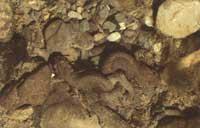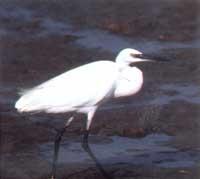Sarrios, excellent height acrobats
1989/01/01 Aihartza, Joxerra Iturria: Elhuyar aldizkaria

Sarrio (Rupicapra rupicapra), is an artiodactile mammal of the bovine family that, despite its scarce presence in the Basque Country, extends in recent years by the Pyrenees. This herbivore classified in the tribe of the goats has a length of 1,1-1,3 m and a height up to the cross of 70-80 cm. The tail is very short, with an approximate length of 4 cm. In the face of solidity, the regulars usually weigh about 2 kg in newborns and when they reach maturity, the male weighs about 40 kg. The female is slender and normally does not exceed 30 kg. However, these values are variable throughout the year, and when in a harsh winter snow prevents access to food, these animals lose weight and lose up to a third of their weight.
The Pyrenean sarrio ( R. rupicapra pyrenaica), smaller and more coloured subspecies than the Alps. This second particularity is more evident in summer, since at this time of year the sarrio presents a short, light brown and reddish coat. In winter it develops a long and compact coat in which the color (especially on the sides and ribs) darkens noticeably.
The development of the branches of Sarriocume begins quickly, first two of the ends that will form the hooks of the strings tilting them back. For Sarrio to be two years old, the distinctive key will be constituted, and from that moment only the branching axes will be extended, adding each year new development rings. The average length of the branches is 17-21 cm.

The differences between males and females are not as evident as in other artiodactyls, so it is especially difficult to differentiate the sexes in the mountains. Sexual dimorphism can be seen in the form of horns: the branches of the male are somewhat thicker than those of the females, and in addition the keys formed by the extremities are stricter. In the case of the male, while the key ends appear oriented downwards, the female ends are directed backwards (towards the tail). (See figures 4 and 5).
The Sarrios, as already indicated, inhabit the high mountains of the Pyrenees, where they can be found both in areas of high pastures and in rocks. These animals that live by day have learned well to escape human beings, and to sleep they also choose high shelters. However, when it pushes cold and snow, they descend downwards and find themselves in fir trees and on the beech borders. However, if it is not too cold, there are also groups that stay in high pastures facing the snow, in which plants covered by snow are carved to emerge and eat.
Their simplicity and strength give them the ability to perform with incredible skills in the most dangerous and difficult territories of the times. Therefore, in the summits and rocky walls, as well as in the most hidden steps of the cliffs and/or mountains, it is frequent to hear the noise of the stones that the sarrio gives off in the escape. And this is, in most cases, the only sign that tells us the frequency.

Being a fleeting animal (and in places where human pressure is high, of course, more fleeting), they leave like the rays of sight, going up and down the ravines, offering an exceptional acrobatics show. Their jumps are terrible and of great precision. Despite traveling about six meters in the air, they can remain on a surface of 30 cm in diameter.
As an adaptation to the environment in which they live, or in the rear of the frequent, different types of transformations can be observed. For example, the edge of the nail that the animals pee appears well developed and is formed by a rubbery substance. In addition, the two halves of the apache are mobile with each other and the sarrio has the ability to move freely.
As Sarrio lives on rocky terrain, it is not common to see footprints, except in winter. The footprints are characteristic. The marks on both sides of each Apatx are angular and between the two halves there is always a clear interval. When walking, the foot footprint is usually rectangular, almost square, but as the speed of the animal increases and due to the movement of the nails acquires trapecial shape. The secondary fingers, located at the back and above the hooves, only leave a mark on the deep snow or when the animal flees.

Unlike soft snow remnants, when the animal escapes, the secondary fingers are printed far behind (about 10 cm behind the primary fingers). The reason is that, after a big jump, when landing the animal, the legs seem love, touching the ground the secondary fingers. The footprints of the Sarrio adults have a length of 6 cm and an approximate width of 3.5 cm. (See 1, Figures 2 and 3).
Except for the older males, we have grouped them together. These groups of rebecos, which can reach up to 100 in heat, are much smaller throughout the year, and are formed by sarriokume, eme and young male.
Zeal begins in November. The main males who lived alone until then concentrate on different groups of females, each of which takes care of a male to become head and take care very carefully. If another male is discovered, the provisional chief is immediately pursued. If the strange male resists him, both will fight. The two males, with their fur on their neck and back very proud, face each other and face each other in an intense clash, with their heads bent, the confrontation. These attacks are often oriented to the enemy's belly, so the advantage of having hooked branches is evident.

Otherwise there would be risk of serious injuries. If these shocks and helmets do not solve the case, the ardent males jam the keys of the branches and try to dominate one strip and the other. In the end, of course, the weakest of the two will have to despair, fleeing.
After the heat of the sarrio comes winter, and this anniversary is hard and long in the places where these animals live. Consequently, this anniversary establishes a rigorous selection in the population of rebecos, since the cold and scarcity of food will cause the death of older and vulnerable animals.
With the arrival of summer, the females come together again in groups and with the playful offspring jumping around, they leave through meadows and steaks of height, until the winters and cold ones return to smoke.
Sarrio therefore has very few natural enemies. The bear, besides being so scarce, is too slow to capture this type of light animals, the fox, again, is not able to attack the hard attack of the sarrio and the royal eagle can run over some sarriocedo, but this predator has no significant influence on the growth of the populations of sarrio. The human being is therefore the main predator that causes the growth of the Sarrian populations. In fact, paleontological and historical data indicate that the rebecos were much more numerous than now.

In Navarre, around Belagua and Larra, there are currently about 30 specimens, but it seems that centuries ago, through the slopes of Mount Orhi, Irati, Abodin, and in Roncesvalles itself, there were also many.
Consequently, the reason that the Sarrians live in the highest areas of the Pyrenees at present must be sought by human pressure, so although their natural habitat is mountainous, it can be said that they have been driven to higher regions than the original ones. Analyzing the growth rates of rebeco populations in the parks and reserves of the central Pyrenees, it is observed that the resilience of these populations is high. Therefore, in the so-called Pyrenees National Park, reproduction rates between 1968 and 1970 are around 13-14% annually. No wonder, therefore, the expansion of the massacre in the Pyrenees, which makes us optimistic for the future of this animal.


Gai honi buruzko eduki gehiago
Elhuyarrek garatutako teknologia




